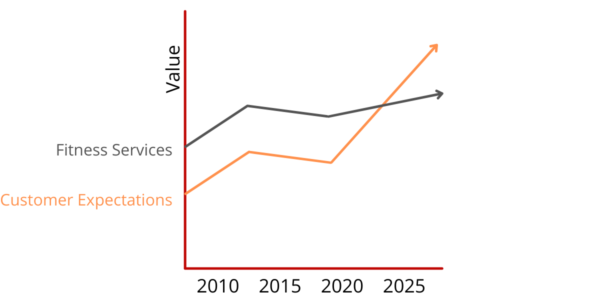Our bold predictions of what the future of gyms will look like in a post-corona world
- January 6, 2021
- Industry Trends
- 7 minutes

There’s no doubt the corona pandemic will have a big and permanent impact on the future of shopping, traveling, working and working out. The providers of that workout space and equipment, namely gyms, felt the full weight of corona restrictions and lockdowns.
Although there is a light at the end of the tunnel, it’s still dim. The vaccine will take many months to distribute to the mass population, so stabilization might not come until closer to 2022. The road to recovery is long for the gym industry.
To cope, we’ve seen gyms get creative and adjust their business to the new normal. They had to innovate. They had to ask their communities for help. They had to cut costs, consolidate assets and reassess their long-term strategies. It’s widely expected that many gyms won’t survive. In general, the gym industry will never be the same. But that doesn’t have to be a bad thing.
Going forward, no one knows for sure what the future will hold. There is still a lot of uncertainty. However, based on where the industry is headed and some educated speculation, we’ve made 3 bold predictions to what is in store for gyms.
1. Digitalization will transform the landscape
Since corona shut the doors to gyms worldwide, gyms have been scrambling to find a solution to offer their members. Many gyms began live streaming their group classes, using technology that wasn’t necessarily developed for that use case. Other gyms published on demand workouts and other online content their members can access on their website but it took months to deploy and still doesn’t meet today’s digital consumers expectations.
Gyms were not prepared to make the transition to a completely online service and many struggled to adapt. When the second wave came, lockdowns were reimposed and restrictions constricted. It became clear that things would not improve as quickly as some had hoped. By this point, more digital fitness products and services had emerged to suit the specific needs of gym operators and members alike that will ultimately change the gym landscape.
Demand for digital fitness services is high.
The corona pandemic pushed gyms headfirst into a digital era and accelerated its development and acceptance of digital fitness products and services. This means that not only will gym operators adopt more digital technologies in the future, but their members will demand them. Soon, just offering online fitness classes, on demand workouts and virtual training won’t be enough. That will become a new base-level expectation for some members.
We found that of those that are currently using an online training platform, 68% said they’d continue to use the service in the future as a complement to physically going to the gym.
That being said, the pandemic was likely just the catalyst to start the race to digitize gyms. It will undoubtedly continue during re-opening and beyond. Presently, gym digitalization has gained enough momentum to keep the gyms in the race, but this comes with new consumer expectations. The challenge now will be keeping up with the new consumer demand while navigating corona guidelines.
Compartmentalized digital innovations will evolve into digital ecosystems.
After giving members the tools to workout at home, gym can’t just take those tools away. Gyms will want to build upon their digital fitness services and integrate them with other services at their gym. With demand for digital fitness services high, more gyms will be looking for long-term, sustainable solutions that build on those core services. Gym operators will incorporate more technologies within the walls of the gym to provide a more inclusive member experience, from smart equipment and virtual workouts to digital leader boards and events.
Following this evolutionary path will inevitably lead gyms to build digital ecosystems around their services. A central component to this ecosystem will be the gym mobile app. Fitness apps continue to trend upward as the number of mobile fitness app users grew 27% since 2019, and although most of that growth comes from the inability to go to a gym, the trend isn’t going away. It’s a good reason to believe gym apps will become more commonplace. Members will depend more on a gym app for information, to plan or schedule their workouts, to track their fitness goals or to engage with the community.
More at-home digital offerings race to capitalize on the new consumer demand.
The corona pandemic wasn’t just a catalyst for the digitalization of gyms, it also accelerated standalone at-home digital fitness innovations. Startups saw an opportunity and built technologies that connect users to a digital fitness community, engage users with virtual trainers and interactive workouts, and provide users access to personalized content, all within the convenience of their own homes and without a gym membership. This could potentially convince some members to exclusively use digital services and cancel their gym memberships. But don’t worry, everyone knows you “never go full digital”.

Besides, it’s expected that the majority will use at-home solutions as a complement to their routine rather than a replacement. But to be safe, consider doubling down on your digital offerings and incorporating them with your onsite offerings so that your gym becomes the center of your member’s fitness journey.
2. Innovative membership packages will emerge
The future is here, but gym models don’t know it yet. To fully incorporate a new digital service line, gyms will have to change the way they do business.
Attaining pre-corona occupancy after reopening may take some time. Some gym members might not rush back to work out in a confined space with other members slinging sweat across the room with each cross-body tricep extension. While you wait for consumer confidence to return, digital fitness services will keep the lights on. Digital fitness services will not only help retain the members that are careful to come back as soon as doors open but could also create additional revenue streams. This will be critical to not only surviving the pandemic, but also capitalizing on an opportunity.
Gyms will start introducing hybrid models.
Memberships will start including online fitness services in addition to the in-gym services already provided. Gyms will have the opportunity to create an ancillary revenue stream from offering online fitness services.
Although, in order for this new revenue stream to be sustainable and beneficial long-term, gyms will need to focus on digital fitness services that are consistent with their brand strategy and in-gym services. Gyms that haphazardly offer services that don’t resonate with their members will spend more time and money on services that don’t bring value to their members.
Additionally, hybrid models that add value by strategically integrating their digital services with in-gym services will incentivize consumers that would otherwise be happy with just digital services to incorporate in-gym offerings as well.
Consumers became accustomed to the flexibility gained from online training and on demand workouts. Even before the corona pandemic shutdown all the gyms, consumers wanted flexibility. Hybrid models have the ability to accommodate that flexibility by providing digital fitness services that complement or enhance in-gym services. Developing digital revenue streams on top of in-gym revenue streams will create more value together than either did alone.
Gyms will introduce or expand on tiered models.
Memberships will be broken into tiers, or levels, depending on the offerings. Tiered options give members the flexibility to choose the membership that meets their needs and budget, rather than a standardized approach.
This will be critical for gyms to reactivate customers post-corona, since members will be more sensitive to price and long-term commitments. Digital services will be included to give more value to higher tiers and will help drive member retention and growth.
Making the transition to a hybrid model and/or tiered model post-corona will be a delicate process. Gyms will need to offer these services at reduced price to regain members without alienating existing members. Upon reopening, gyms must revise and align pricing and customer acquisition strategies to accelerate growth while also being cognizant of new customer sensitivity. In the long term, gyms will focus more on stabilizing their business and returning their balance sheets to profitability.
3. Member expectations will change
We’ve already touched on some ways consumer expectations will change post-corona, but we think this is an important topic to elaborate on.

Are you ready for change? Because your members are. We think it’s fairly safe to assume that your members will expect more from you following the pandemic. In order to meet these expectations, first you need to identify them. Gyms that don’t realize that their members expect more or will have a hard time satisfying their members. The future holds plenty of new expectations gym members will have that you will need to satisfy, but this article will try to predict a few you should pay closest attention to and how they will spark change in gym operation.
Member perception will redefine Price and Terms of memberships.
Not only will the gym members of tomorrow expect online fitness services, they will also be more sensitive to price and commitment. Times are tough so higher-priced memberships aren’t afforded by many and long-term commitments are scary amidst all the uncertainty. Consumers adopted new ways to stay fit without a membership during the pandemic and some discovered they enjoyed it. This realization will change how consumers perceive value when it comes to their fitness needs.
Therefore, gyms will be strategically priced and modeled to attract the members they lost, and beyond that, operate in a new world. They’ll commit more value to their offerings to live up to their members new expectations.
Gyms will have to work hard to regain consumer confidence.
Even though must gyms reopened across Europe and in the United States, some members might not feel comfortable rushing back. To get members through the door, gyms will have to take convincing measures to assure them it is safe. Whether that is investing in a new air purification system, enforcing a strict social distancing policy, or directing staff to sterilize equipment more frequently. There is no quick fix. It will take months for the cautious member to feel comfortable at a gym again.
Gyms will integrate personalization into their digital ecosystem.
It was a trend before the pandemic and it’s even more relevant now. Your members are going to want more personalized services to go along with their digital appetite. You can thank Amazon and Netflix for introducing hyper-personalized digital platforms. When it comes to digital fitness services, it will be no different.
“Hyper-personalization involves creating an engagement experience that’s customized for, specific to, a given user,” explains Bryan O’Rourke, president of the Fitness Industry Technology Council (FIT-C) “It’s about convenience, about reducing the number of steps a person has to take to get what they want.”
Gyms will learn that in order to deliver a valuable and engaging customer experience, they will need to offer some kind of personalization. Gym members are going to want to search and browse for classes that interest them, save and organize classes for next time, set preferences like time of day and workout type, schedule classes and set up reminders, track goals and fitness metrics, engage with the community, and so on.
Members will discover a greater appreciation for the social aspects of gyms.
Remote friends are just not the same as IRL friends. We’re all human in the end and crave in person interaction.
Gyms that see the unique position they are in will double down on member engagement. Simply making sure your members are welcomed back and engaged by staff (at a social distance, of course) might make the difference between losing and keeping a member.
Additionally, gyms will use their newfound digital channels to increase touch points with their members and empower community interaction, online and in-person.
How gyms handle the crisis will have an impact on member perception.
The way gyms respond to the crisis will be scrutinized and perceived accordingly. Their reputation will be defined based on how their decisions and actions are perceived.
Gyms that communicate transparently, reliably and clearly will be well-perceived while those that communicate dishonestly, unpredictably, and unreliably will earn a bad perception. Asking for help isn’t necessarily perceived negatively, and could instill a deeper sense of community if done properly. Ultimately, how members perceive the way operators handle the crisis will create either loyalists or defectors.
Final Thoughts
The gym of tomorrow looks very different. The corona pandemic will surely transform the gym industry as digitalization forms new opportunities, business models and consumer expectations. Gyms that don’t evolve with the changing digital landscape will eventually become extinct. Those that anticipate changing consumer expectations, invest in developing digital ecosystems and adjust their business models accordingly will see a new tomorrow. Our fitness tracking and member engagement platform can help you capitalize on that opportunity. Contact us to find out how or subscribe below to stay tuned.
